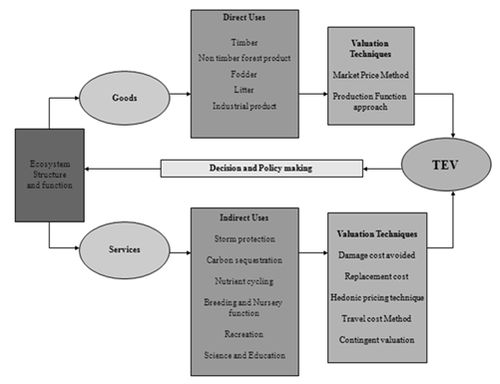|
Introduction
Ecosystem functions are those processes which includes the exchange of energy between the plants and animals which are needed for the sustenance of life. These functions include nutrient cycling, oxygen regulation, water supply etc. The specific ecosystem functions which are beneficial to humans are termed as ecosystem services. Thus ecosystem goods and services are the conditions and the process through which natural ecosystems and the species that make them up sustain and fulfill the human needs (Daily, 1997). Forests are multifunctional ecosystems provide both ecological and economic security with provision of goods and services. Forest ecosystems account for over two-thirds of net primary production on land–the conversion of solar energy into biomass through photosynthesis making them a key component of the global carbon cycle and climate (MEA, 2005). Forests worldwide are known to be critically important habitats in terms of the biological diversity they contain and in terms of the ecological functions they serve. The forest ecosystem provides a large number of valuable products such as timber, firewood, non-timber forest product, biodiversity, genetic resources, medicinal plants etc. There are two types of needs for timber-commercial and industrial. The commercial timber production is the local utilization of timber while the industrial timber is used by the industries. The second most important and dominant part of forest produce is fuel wood. According to International Energy Agency (1998) 11% of world energy consumption comes from biomass, mainly fuel wood (CBD, 2001). In addition to the timber and firewood, forest provides the non timber forest product (NTFP) like seegekai, honey, wax, etc. For the purpose of valuation it is important to take into account all resources including NTFP, etc. Most of NTFPs consumed by local populations, and some are marketed. These include plants and plant materials used for food, fuel, storage and fodder, medicine, cottage and wrapping materials, biochemical, as well as animals, birds, reptiles and fishes, for food and feather. Unlike timber-based products, these products come from variety of sources like: fruits and vegetables to eat, leaves and twigs for decoration, flowers for various purposes, herbal medicines from different plant parts, wood carvings and decorations, etc.
The survival, livelihood and human welfare depends upon the flow of array of goods and services obtained from ecosystem. Inventorying and valuation of the flow of goods and services is essential for appropriate ecosystem management decisions. Ecosystem goods and services represent the benefits human populations derive, directly or indirectly, from ecosystem functions (Costanza et al, 1997) or the benefits people obtain from ecosystems as well as non-utilitarian sources of value (MEA 2003). Despite the essential functions of ecosystems and the consequences of their degradation, ecosystem services are undervalued by society, because of the lack of awareness of the link between natural ecosystems and the functioning of human support systems evident from most of the contemporary approaches based on utilitarian approaches (CGER, 1994). The ecosystem goods and services with the ecological perspective of valuation can be grouped into four different categories, which are:
-
Provisioning services – it includes products i.e., food (including roots, seeds, nuts, fruits, spices, fodder), fibre (including wood, textiles) and medicinal and cosmetic products.
-
Regulating services – which are of immense importance to the human society such as (a) carbon sequestration, (b) climate and water regulation, (c) protection from natural hazards such as floods, avalanches or rock-fall, (d) water and air purification and (e) disease and pest regulation.
-
Supporting services – such as primary and secondary production and biodiversity; a resource that is increasingly recognized to sustain many of the goods and services that humans enjoy from the ecosystem.
-
Cultural services – which satisfy human spiritual and aesthetic appreciation of ecosystems and their components.
Figure 1 provides an integrated framework for assessing the ecosystem goods and services (De Groot et al,2002). The total economic value (TEV) is the sum of all the benefits that are attributable to the specific resource or ecosystem being valued. The total economic value is composed of (i) use value (UV) and (ii) non-use value (NUV). Use value to humans consists of direct, indirect and option value. Direct-use values can be consumptive or non-consumptive and are commonly derived from goods and services by the inhabitants of the ecosystem whereas Indirect-use values are those that are more functional, the benefits of which often extend away from the ecosystem itself and are not consumed. This communication is based on the valuation of provisioning services of forest ecosystem in Uttara Kannada district, Karnataka state, India.
This involved
-
Quantification of various provisioning goods and services derived from forest;
-
Total valuation of provisioning goods and services derived from forest.

Figure 1: Integrated framework for assessing ecosystem goods and services
|


